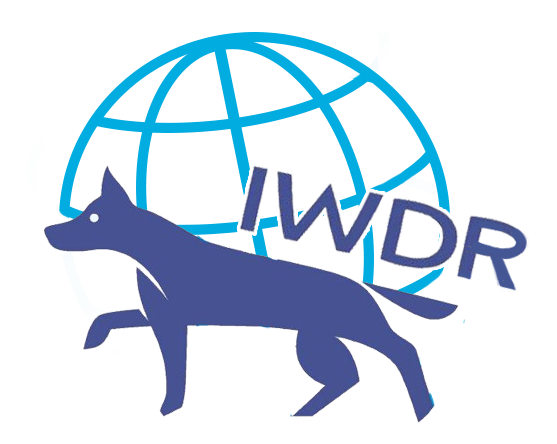Early Socialization - Beyond Week 8
![]() TIP: Click the quick-links above to go directly to each section. You can also click the anchor icons at each section to return to the top of the page.
TIP: Click the quick-links above to go directly to each section. You can also click the anchor icons at each section to return to the top of the page.
Quick Reference Guide:
Goal:
Continue building positive experiences! Be creative and aim for novel items and experiences during activities. Make sure to still let puppies have rest and downtime.
Environments:
Passive environmental enrichment- Litter’s den, play area, or outdoor area with precautions in place – ![]() click to view our Biosecurity section. Interactive activities can be done in a separate clean room, litter’s play area.
click to view our Biosecurity section. Interactive activities can be done in a separate clean room, litter’s play area.
Volunteer Type:
Volunteers can be very helpful for socialization of older puppies, but make sure they are trained in body language and handling.
Introduction
After their 8 week vaccinations, puppies are able to begin exploring the big wide world. Many organisations aim to have their puppies in raiser/carer homes by this age but this is not always possible. The following content is aimed to provide enriching and educational activities for both puppies in facility or home environments. Depending on your available resources, you can pick activities most relevant to your organisation’s needs and abilities. Make sure to provide the puppies with a regular routine. Remember, the aim is to prepare the pup for a life of ongoing learning and working, so all activities must be fun and enjoyable. It is important that you proceed to more advanced parts of the skills only when the pup is ready, as advancing too quickly can affect their outlook on work and learning, as well as inadvertently teaching them the wrong way to do things. Slowly introduce more key skills and build your pups self control.
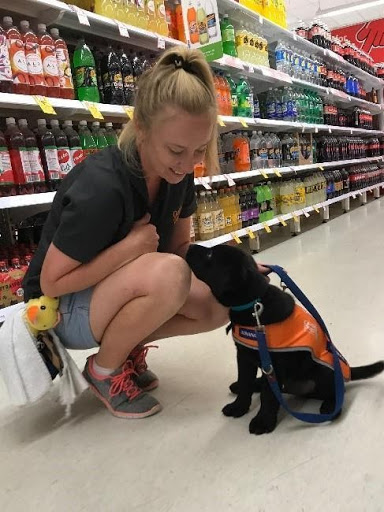
- Pups will happily explore the new environment
- Pups will play with littermates then fall asleep
- Pups will display no stress signals or if 1 or 2 stress signs (yawning, whinging) but pup quickly resolves inner conflict without escalating to additional stress signals.
- Second exposure pups are accepting of longer durations
- Addition of familiar surfaces, massage and textures accepted without issue.
| KEY | SOCIALISATION TRACKER |
| 1 Engaged | Actively engages with handler/environment without showing any signs of stress. Consider increasing the 3D’s to allow puppy the opportunity to reach the yellow (learning) zone. |
| 2 MOSTLY Engaged | Actively engages with handler/environment but may shows signs of mild stress. Pups may leave the green zone and enter the yellow zone. The pup will often show this by lip licking or sniffing in response to an exciting or stressful situation the brain will release a chemical into the body, creating a build up of emotion energy which reduces their ability to learn. Your role is to give the pup time to release the emotional energy |
| 3 Learning Opportunity /Sorting out / Processing/Uncertain | Should the pup enter the yellow zone it will need to be given time to release the emotional energy. You can assist the pup by adjusting the distance, distraction, and duration and this will usually result in the pup returning to the green zone. The ability of a pup to return to the green zone by itself helps develop self-modulation, which is an important attribute in guide or working dogs.Requires some encouragement to engage with handler/environment/ and/or shows mild stress signals |
| 4 Learning Opportunity /Sorting out / Processing /Uncertain | Requires substantial encouragement to engage with handler/environment and/or shows moderate stress signals. Warning: Puppy is quickly reaching a state in which it will be unable to learn positively. During this time, the puppy may show reactions to objects, stimuli etc that it previously appeared to be comfortable with. |
| 5 Overwhelmed | Uncomfortable. Unable to engage with handler/environment and/or shows severe stress signals.Pups in the red zone (shown by jerky movements, trying to escape, increased scavenging or vocalisation) are not able to resolve the stress on their own. Your role is to help the pup by adjusting the 3 D’s. The aim is ideally for the pup not to enter the Red Zone because you have given him the opportunity to release his emotional energy while still in the yellow or orange zones. |
- After all sessions, please ensure you allow pups some calm, quiet time. Pups still tire easily and need a lot of sleep. Encouraging quiet time also sets the pup up to enjoy sleeping or entertaining itself when doing nothing. This is an important skill and will help the pup throughout their life, with raisers and clients, both at home and when working. Baby pens can be set up in areas you are using. This allows the puppy to sit and listen to sounds, conversations, laughter, and normal office noises. This helps teach pup to relax in between work.
- Skill building also assists in creating responsibility in the pup, so it chooses you. Follow me that was started from week 4 set the pup up to engage with the handler and now by adding checks in you are adding a new level to this skill.
- By being aware of your own body language you are starting to communicate with the pup in a language it understands. Always give clear, consistent communication to the pup so it will succeed.
- Helping the pup to be well mannered on and off the leash is achieved by using your skills to engage the pup, instead of managing using the leash or avoiding access to anything distracting.
- Continue to build your relationship with the pup so it remains attentive to you especially on walk so there is no pulling on the lead. Loose lead walking is one positive you can give to the puppy raiser to make their role easier. Concentrate on this as it is harder to learn then sit or down.
- The puppy raiser will thank you for helping to hand over a pup that is a pleasure to walk and responsive to handlers.
Remember all pups are individual so work at the pup’s level not at the level of other pups in the same litter. It’s all about setting the pup up for success and building human relationships.
Remember to document all that you observe. Do not attach titles like stubborn, self-centred, rather describe the context in which the behaviour occurred. For example, pup was hesitant to approach, had low body carriage, tail between its legs. Add anything you tried and what worked to help pup.
Skill building is an ongoing process and it is essential to start during the critical learning period. Some of the skills being taught will be utilised throughout the puppies’ lives while others will provide the pups with a solid foundation upon which guiding/service work can be taught.
Puppies do not naturally know what we want so it is our role to patiently teach them what we want in a calm, relaxed, enjoyable fun environment. We must maintain and then gradually build up pup’s skill level until the pup can reliably perform the skill, before moving onto the next level. Building reliable skills results in the pup responding to your commands in any situation and remaining in that position until you release it.
During skill building exercises our role is to allow the puppy to have fun while working with you and to choose you, despite any distractions. Each time we work with the pup we are building the pup’s desire to work with you instead of working for a food reward.
Before pups go to puppy raisers your role is to preload them with skills that they are confident to perform and understand well.
We are building up the following skills:
1. Name response
2. Sit (used in various situations such as doors or mealtime)
3. Down
4. Follow me and check in
5. Body handling & close
For these skills we use the marker word “YES” when the puppy does the right thing. For example, when teaching “sit”, we wait until the puppy’s bottom touches the ground – and that very instant we say “Yes” and then give the puppy a food reward. This builds a positive association to the word “yes”, and puppies will soon learn that when they hear “yes”, they’ve done the right thing. This is generalized easily by the puppy, and is the foundation of teaching puppies harder skills. Remember:
- “Yes!”
- Treat
- Praise
For more specific instructions surrounding these skills, please review the Interactive Activities section.
Skills can be taught by luring (using food to lead the puppy to the desired position) and shaping (capturing moments that the puppy is naturally in the desired position).
When teaching a new skill, it is important to build on it gradually, so the pup has the best chance of succeeding. The 3 D’s of teaching a new skill are Duration, distance and distraction.
Introduce them in the following order:
- Duration,
- Distance,
- Distraction.
Keep in mind that any time you add duration, distance, or distraction, you must reduce the requirements for the other two.
For example, if you add distance then you must reduce both duration and distractions to give the pup the best chance of success.
- Duration: Firstly, add duration while remaining stationary and in an area that is free of distractions .
- Distance and Distraction : Once you have built some duration, you can add distance or distraction. Ensure that you reduce the duration that you are asking for to help the pup succeed. Our role is to always set the pup up for success.
Luring
- Lure puppy into position
- Repeat until pup is easily moving into position
Adding a verbal cue
- Add the verbal cue then the marker word “Yes!” as the pup does the behaviour
e.g. Say “Sit, yes!” as the pup’s bottom touches the ground
- Repeat 1-2 more times
Fading the visual cue
NOTE: Only start fading the visual cue after a few sessions of the pup performing the cue well in various environments
- Start in an easy environment with no distractions
- Say your verbal cue then follow up with the visual cue
- Repeat the above steps gradually adding more time between the verbal and visual cue
- Once the dog start to do the behaviour after hearing the verbal cue but before the visual cue is given, you can start to only give a verbal cue
Generalising the cue
- Practice the skill in various environments – If the pup struggles to follow the cue in the new environment, you can go back to luring ONCE OR TWICE to remind them what is being asked
- Practice the skill with the only the verbal cue at least three times before leaving the area
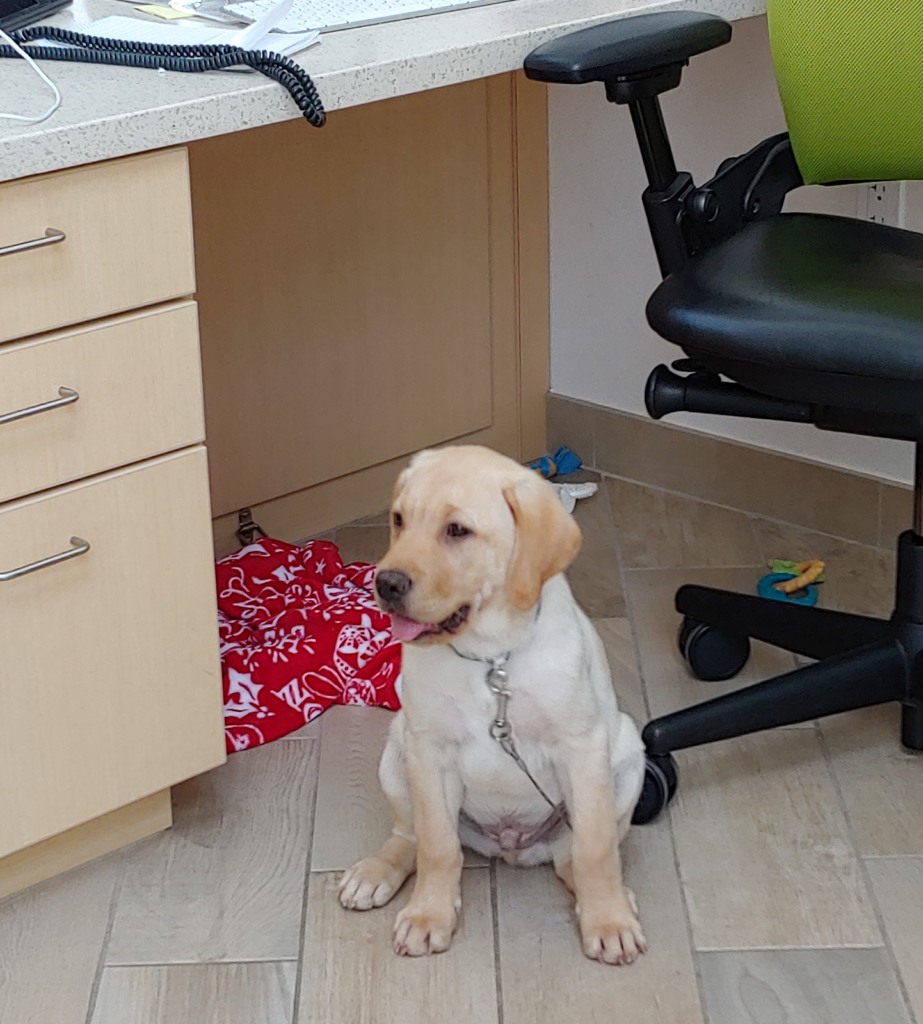
Problem Solving
Should pup not be responsive assess things like tiredness or just having an off day for learning and engaging. Consider whether the pup is stressed – can you see any stress signals? Sometimes the pup is not in a learning mode, so it is best to leave on a positive rather than teaching what you do not want from the pup. Going back to a known skill like sit then leaving has set the pup with success prior to leaving. If the puppy does appear stressed, give him some time to resolve the conflict on his own before progressing or continuing with the activity.
This is a broad topic and must be managed differently depending on the age of the litter and the particular interactions within the litter. Please click here to view our information on this.
Always focus on the fundamentals initially then gradually build up the new key skill. When teaching a new skill, it is important to build on it gradually, so the pup has the best chance of success. it is best to practice the new skills multiple times in a variety of situations.
The progression of the new skill in small slices is paramount while increasing duration, providing more distractions or while at a greater distance – yet alone when trying to combine any two or all three.
This all takes time so start slowly and remember short positive sessions are best. Multiple brief sessions can be done throughout the day to assist the put to process the skill. Although food reward can be used initially but the aim is to have your pup choose you and focus on you not the food reward. This is important when trying to work through a distraction.
Always acknowledge when your pup does check in with you. Food is not the reward but the use of you through your body language like a smile, verbal praise, or change in energy so pup knows it has done well and you are extremely pleased.
The pup is learning that being with humans is fun. Over the past weeks the building of human relationships will start to show benefits with the pup choosing you most times.
Should something not be working then change what you are doing! Consider what does and doesn’t work for your individual puppy. Why is the pup not performing – is it stressed, tired, ill, distracted, disinterested?
Signs that tell you the pup needs immediate help include:
- Severe change in energy-inhibited or activated, not engaged
- Long period of time needed to resume activity
- Fight or flight response- Puppy is not actively learning
If pup is in the red zone review your technique and ensure you are working pup at a level that ensures success. Sometimes going back to an earlier skill level and building up again can be helpful. Reduce the 3 D’s and make sure you are giving puppies enough time to rest. Consider the stimuli that caused the reaction and why. Was there one major event or a number of small events?
This is the time to employ distancing. Use your relationship skill to get the pups attention back on you.
Reward highly and generously for the pup choosing you by using your body language/ puppy skills – smiles, verbal praise, a happy voice. Have pup practice a known reliable skill like sit, to allow you time to assess the best way to continue so the pup is successful.
It might mean going back a few steps so reinforce the behaviour you want then trying again. The use of another person to mimic the previous setting with clear instructions on how you want them to help the pup success can often be beneficial.
Interrupt verbally if pup starts to scavenge (Ah ah!). Use your skills to make sure pup chooses you over the item. Remove anything from their mouths that they pick up.
Troubleshooting for Excessive Scavengers
If you see something the pup is likely to scavenge, pre-empt this by tickling them on their side or talking to them to distract them as they go past it. Your role is to ensure the pup chooses you over a distraction, because you are more fun. By pre-empting you help to set the pup up for success. *In severe cases/emergencies you can use a lure to guide the pup past a distraction, but use this as a last resort. The pup should be engaged and working with the handler.
Review our material on Crate Training.
Stop and place hands around pup’s chest area. Do some gentle circular motion with your hands. Once pup is calm again you can resume the body handling.
It can help to go back to an area on the body that pup is comfortable being handled and try again.
Should pup still not be comfortable reduce the session times then build up again.
Try luring with slower, more deliberate movements. Make sure you have pup’s interest in the lure and maintain that connection. Practice moving your arm with a “mixing bowl” movement – wide, sweeping and steady.
Passive Environmental Enrichment
Working dogs encounter a variety of sounds throughout their career. Some dogs may travel with their partner through busy cities while others may go to the Opera or loud concerts with their partner. With all of the different sounds a dog may encounter, we want our puppies to be comfortable and confident with many different sounds during their critical socialization period. During this week, we will focus on positive interactions with different sounds.
Environmental sound CDs as well as music or talk back radio can be played. If there is an extra small metal crate a DVD player or computer laptop can be placed in the locked crate and a movie played. Lots of variety to keep pups interested.
Turn sounds on and off as well as changing the direction the sound is coming from. Our aim is to have the pups to be aware there was a change happening rather than then blocking out sounds that are playing continuously.
Continue to play passive unpredictable sounds for the puppies in their kennels or outside in their play area.
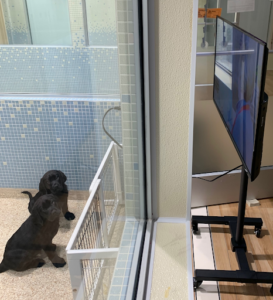
Hand-held sounds items as well as interactive sound objects can be used during this activity. Below are age-appropriate examples for both hand-held objects as well as other sound items that puppies can interact directly with.
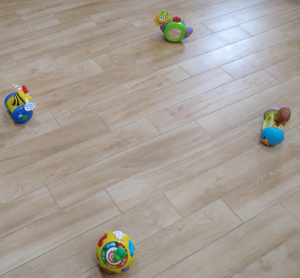
Goal: To allow puppies to explore multiple sound objects with a handler and to be comfortable with a variety of sounds.
To prepare the designated space for this curriculum, please complete the following steps.
- Gather 5 noise objects and 2 handheld noise objects. Remember variety when selecting objects.
- Place the handheld noise objects on a nearby counter or out of puppies’ reach.
- Arrange the objects in a circle spread apart enough for the puppies and handler to move around comfortably.
You are now ready to retrieve the litter of puppies you are working with.
- Allow the puppies to explore the room upon entering for up to 30 seconds.
- Use the hand-held noise objects when the puppies are playing and exploring the room.
- Encourage the puppies to explore each of the objects with you.
4. Continue around the circle in the same manner
Mobile Smart TV-
Passive exposure to TV or movies creates an unpredictable “real world” safe environment inside of the kennel. Below are examples of channels and movies and their benefits:
| Channel or Movie Examples | Benefits |
| Children cartoons | Variety of different character voices and unusual noises |
| Nature | Passive and controlled exposure to thunder, rain storms, birds chirping, water flowing, etc. |
| Musicals | Variety of singing, laughter, and noises |
| Disney Movies | Variety of singing, laughter, and noises |
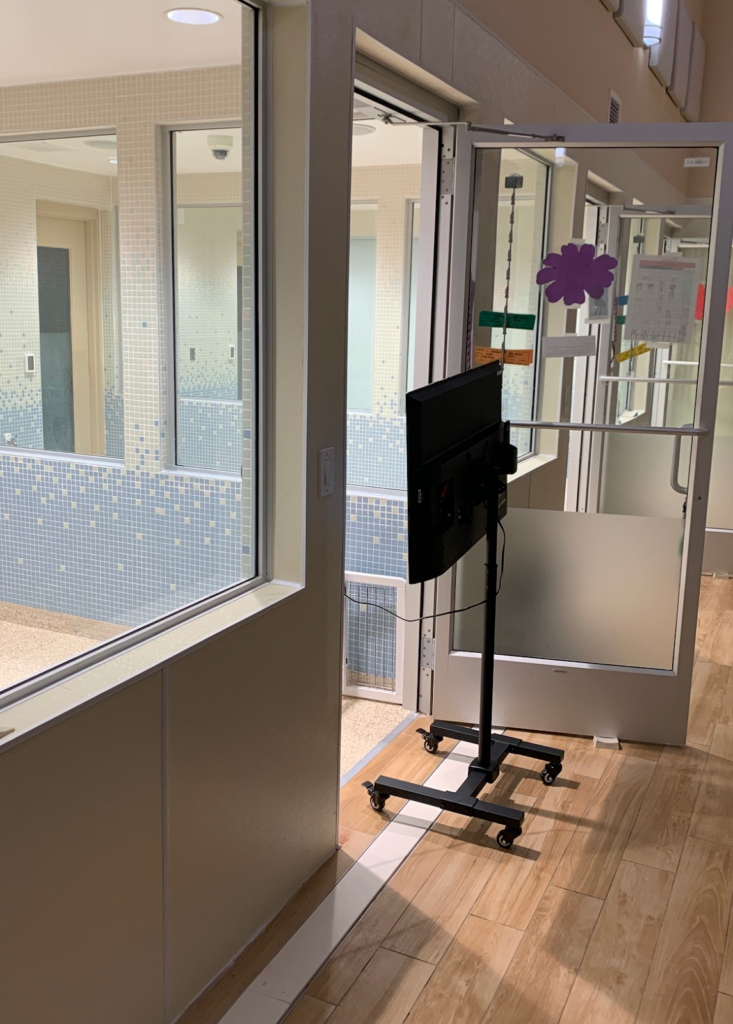
This TV is mounted on a mobile TV stand. The height of the stand can be adjusted for the age of the puppies.
Alert symbol Make sure that wires are out of the puppies’ reach when setting up.
Play TV at a low-medium volume level. Watch the puppies’ body language and turn down the volume or change to a different channel if puppies begin to show stress signs.
It is important for working dogs to be comfortable with walking over different types of surfaces such as grates and uneven pavements. Puppies learn quickly that walking over bumpy and open surfaces is completely normal.
It is important to have a variety of surfaces for the puppies to walk on so they do not grow accustomed to only walking over one particular surface. When selecting equipment, think of having different textures and materials.
Continue to build confidence on different surfaces and elevations in the puppies’ play area.
More challenging surfaces can be added in the litter’s room to encourage them to climb and walk over different surfaces. This helps build the puppy’s confidence and also their muscles! Keep in mind that the surfaces need to be age and skill appropriate.
Examples of age appropriate surfaces include:
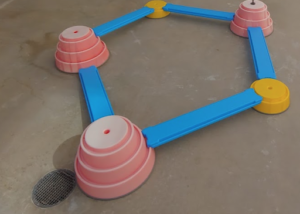
Elevated and Uneven surfaces: Builds confidence and increases limb strength

Goal: For the puppies to confidently explore each surface with a handler.
- Choose a variety of 5 surfaces. Items can be different heights, just be mindful of the puppy’s height, do not make it unsafe for the puppy.
- Arrange the items in a circle with enough distance for the puppies to walk comfortably around each item.
You are now ready to retrieve the litter of puppies you are working with.
- Allow the puppies to explore the room upon entering for up to 30 seconds.
- Encourage the puppies to climb on or walk over all of the surfaces.
3. Continue around the circle in the same manner.
Working dogs must be accepting of a variety of novel objects they may encounter in the community; so, it is important that at an early age they begin to build their reference library of unusual items, including those that move, so that they are comfortable and confident with different novel objects.
Working dogs must be accepting of a variety of novel objects they may encounter in the community; so, it is important that at an early age they begin to build their reference library of unusual items, including those that move, so that they are comfortable and confident with different novel objects.
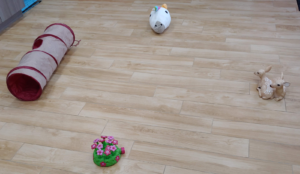
Novel Objects Protocol
Goal: To allow puppies to explore multiple novel objects with a handler and to be comfortable with novel objects.
To prepare your designated space for this activity, please complete the following steps.
- Gather 5 novel objects. Remember variety when selecting objects.
- Arrange the objects in a circle spread apart enough for the puppies and handler to move around comfortably.
You are now ready to retrieve the litter of puppies you are working with.
- Allow the puppies to explore the room upon entering for up to 30 seconds.
- Encourage the puppies to explore each of the objects with you.
- Continue around the circle in the same manner.
Safe items that move can be placed in the litter’s room to allow puppies to explore on their own.
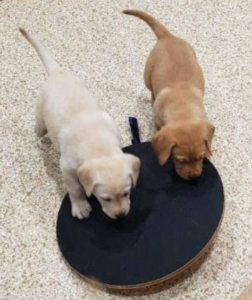
Working dogs need to be comfortable walking on unstable objects and comfortable with objects that move. It is important that puppies learn to be confident with walking on unstable objects and with moving objects.
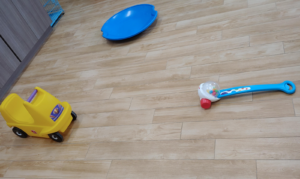
Goal: To allow puppies to explore multiple motion objects with a handler and to be comfortable with walking on unstable objects and moving objects.
To prepare the designated space for this activity, please complete the following steps.
- Gather 4-5 motion objects. Remember variety when selecting objects.
- Arrange the objects in a circle spread apart enough for the puppies and handler to move around comfortably.
You are now ready to retrieve the litter of puppies you are working with.
- Allow the puppies to explore the room upon entering for up to 30 seconds.
- Encourage the puppies to explore each of the objects with you.
- Continue around the circle in the same manner.
Ensure you introduce a large variety of new people, start gradually to build up pup’s acceptance of difference. Demographics to cover include; young, elderly, male, female, toddlers, different ethnic groups
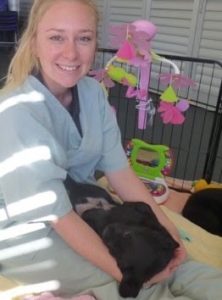
Puppies can now begin to get used to settling inside a closed crate. You can review further information on crate settling here.
Some tips:
- Soft bedding and interactive toys will help to promote positive associations around the crate. Make sure to supervise puppies with bedding in case they chew it. If the puppy chews bedding, remove it for the safety of the pup and make sure you provide appropriate chew toys while the pup is in the crate.
- Pup should spend time in a crate away from their littermates but around people. Puppies need to learn to settle in their crates while people are around, as this will prepare them for crate time in their raiser’s home.
- Offer the pup a stuffed Kong or nylabone.
- Start off slowly to build positive associations: gradually increase time in crate from 5 min to 30 mins. Make sure to toilet the pup before and after.
Interactive Activities
- Purposeful play with littermates exploring novel objects, sound objects, motion objects, and surfaces
- Puppies will develop positive experiences with body handling
- Puppies build positive associations with new objects and sounds
- Puppies build handler engagement
experiences around body handling, and puppies can build positive association with new objects and sounds. Every interaction with the puppies continues the building of handler engagement.
It is important to start to build a solid foundation of skills. Body Handing is ongoing and involves lots of practice. It can be done in short sessions throughout the day in order to set the pup up for success by keeping skill training fun and expectations consistent. Body handling is the process of teaching our puppies to accept all parts of their body being handled while remaining calm while we touch and move all parts of their body.
This is beneficial for health/Vet visits. These skills also help with body sensitivities to equipment the pup may need to wear such as boots or coat.
Remember, Body handling should be a calm, gentle process – it’s not a time for cuddles or play – that can come later! Take extra care around your pup’s teeth, ears and paws – these areas are crucial for Body Handling but many pups find the handling of these areas strange at first.
Start by Teaching the “Close” position:
- Start by crouching on the ground with the puppy in front of you, facing you.
- Place your right knee on the ground – If pup is on a lead put the lead under your knee so both hands are free 3. Use your left hand to lure the pup from your right knee in a circle until they are between your legs facing away from you
- Tilt your lure back over the pup’s head so they go into a sit
- Mark and pay
- Put your knee down so you are kneeling with pup sitting between your legs and place your two hands on the pup’s chest
- Repeat steps 1-6 until pup is quickly and easily moving into position as you lure
- Repeat steps 1-6 but this time say the word “close” just as their bottom touches the ground Do this 3 times 9. Fade the lure and work on duration – Reward pup for being still and calm. Ignore any wriggling or mouthing.
- Do this 3 times
- Fade the lure and work on duration – Reward pup for being still and calm. Ignore any wriggling or mouthing.
Handling Method
NOTE: For pups over 3 weeks, all handling starts in the “Close” position.
Ears
- Gently hold the puppy’s chin with one hand then use the other hand to lift their ear
- Look inside and smell their ear for any signs of infection
- Repeat with the other ear
- Gentle praise, reward
Eyes
- Hold puppy’s chin gently and look at each eye
- Gentle praise, reward
Teeth
- Gently hold pup’s chin and use the other hand to lift pup’s chin on one side to look at their teeth
- Repeat on the other side
- Gentle praise, reward
Legs and paws
- Run your hand down one of pup’s legs to their paw
- Feel between the pads on their paw
- Gentle praise, reward
- Repeat with other 3 paws
Vet Restraint
- Use your left hand to gently restrain pup’s head against your chest so they are looking towards your left
- Run your right hand down the back of the pup’s right leg to their elbow then raise their leg (it should be outstretched as if for a blood draw)
- Mark and pay
- Switch so pup is facing the opposite way and the other leg is outstretched
- Gentle praise, reward
Lay Over
- Place one arm underneath pup’s front legs
- Lift your arm (therefore lifting the pup’s front legs)
- Lean down until you are lying over the top of the dog
- Remove your hand from under the pup
- Gentle praise, reward
Release cue
- Tell the puppy “Go free” and allow them to break position
- Give them a pat and plenty of praise
- Normal life is full of distractions, so it is important to use your handler skill to assess the best times and places to work on the pup at their skill level.
- Ensure pup is toileted prior to any on-site field trips
- Take one pup per person to the designated area. Session lengths & even locations may vary for individual puppies.
- Watch for stress signs – LEAVE IF PUP BECOMES OVERLY STRESSED or stops responding to you.
- Handled by a staff member or experienced volunteer and petted by max 3 people per session. Be aware that holding a puppy does not allow for the puppies to move away. Better to allow pup to have an escape route.
- Not to be petted by anyone initially until the pup has learned some polite meet and greets. Pup must maintain four paws on the floor and has a reliable sit duration. Should pup jump up no petting allowed. Pup should also not be petted by everyone they meet.
- It is helpful to practice polite greetings, so pup has a good understanding of what is expended prior to new people patting. Before patting is allowed get the pup in a sit position while explaining to the other person how to respond to pup.
Facility Locations
- Reception & common areas: added bonus of potential visitors as socialisation opportunities – however seriously consider Biosecurity (e.g. bring hand sanitizer) and the emotional needs of individual pups.
- Offices: Practice handler interactions as you move between offices. Say hi to some people and work on pup ignoring others by focusing on you and practicing sit or down.
Off-Location Outings
Biosecurity Warning!
- People’s houses: beware of and limit access to any other pets in the home.
- Park walks, bush/forest walk locations, wetlands, beaches/lakes: make sure to consider the age of the puppy and research the location beforehand to ensure it is appropriate and you will be able to help pup succeed (considering the length of the trip and possible distractions, etc).
- Shops or public areas where dogs do not commonly have access (due to increased risk until puppies are fully vaccinated) e.g. small shopping plazas
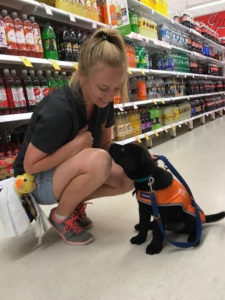
- With the use of balance equipment, puppies learn to utilize their core muscles and balance on equipment.
- Stepping over cavalettis and onto different equipment teaches puppies limb awareness.
- The puppy quickly gains confidence through being rewarded for stepping on and over items.
Goal: To accustom puppies to age-appropriate conditioning equipment to increase confidence and handler/puppy relationship.
Age Appropriate Equipment include:
Bone balance cushion: This larger cushion builds off of the round balance pad and adds a more challenging balance exercise for puppies.
- Large balance ball: This uneven surface strengthens puppies’ core muscles as they balance on the equipment.
Peanut *Requires handler to stabilize peanut: Puppies gain confidence when maneuvering their body on the peanut. Ask puppies to place their front paws on the peanut and slowly lure them over the peanut. Do not let puppy stand on the peanut.
- Wedge: This piece of equipment helps strengthen the puppy’s legs as they learn to walk on inclines. The nubby surface allows the puppies to become used to stepping on uneven surfaces.
- Cavalettis: Puppies build their proprioception skills stepping over cavalettis. Set 2 pairs of cavalettis up next to each other for an extra challenge once the puppy is comfortable stepping over the cavalettis.
- Cones: Walking in different directions helps strengthen puppies’ leg muscles. This exercise also requires the puppies to focus and work with their handler.
- Other equipment options: Brooms, mop handles, long sticks. Make sure to keep close together for the puppy to easily step over the items. You can use anything that the puppies have to walk around- laundry baskets, chairs, buckets, etc. Try to keep the items small for the puppy to easily follow the handler.
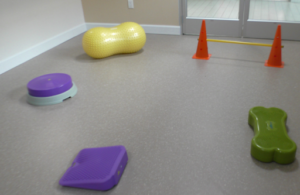
Protocol
To prepare the education room for this curriculum, please complete the following steps.
- Gather a treat bag with age-appropriate food.
- Gather 5 age-appropriate pieces of conditioning equipment.
- Arrange the objects in a circle spread apart enough for the puppy and handler to move around comfortably.
You are now ready to retrieve the puppy you are working with.
- Allow the puppy to explore the room upon entering for up to 30 seconds.
- Call the puppy to you and use a food reward to lure them to step on the first object.
- Encourage the puppy to follow you to the next object and lure them to step on the next object.
- After completing the first rotation, use a food reward to lure the puppy to walk across or stand on each object.
5. End the session on a positive note after the second rotation.
Puppies can spend time safely secured via crate at desks during the work day. This gives puppies a new environment outside of the kennel environment to practice settling which is an important skill they will practice with their raisers. Below are a few notes for this activity. You can also consider using volunteers to prepare the areas for the puppies and to watch or check in on the puppies and return them to their kennels if needed, should the puppy be too distracted by (or distracting to!) staff.
Before bringing the puppy to the desk area:
1. Look around the area to address any safety concerns such as:
- Items that have fallen on the floor
- Wires that could possibly be in the puppy’s reach
- Trash cans
2. Set up the area
- Gather a crate or tie-down
- Gather a few safe toys for the puppy to play with
3. Give puppy time to relieve before beginning this activity
Aim to keep the puppy at the desk area for half an hour to an hour. If the puppy is unable to relax and appears restless, give the puppy an opportunity to relieve. If the behavior continues or escalates, return the puppy to their kennel. Next time, shorten the session so the puppy remains comfortable and relaxed.
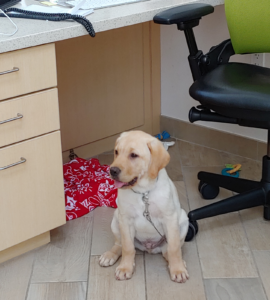
Self-Settle
- Have pup on lead
- Sit or stand without interacting with the dog
- Wait for them to settle without being cued in any way
- Mark and pay when pup lays down
- Reward them intermittently for remaining calm and in a down
- Once pup settles within 1 min you can move to the next location (see Skills Tracker)
NOTE: If they get up, just ignore them, and wait for them to settle again, then praise them but do not reward until they have been lying down for a little while.
Parking
- Have the pup on lead
- Park the pup (place your left foot on the lead at a distance that gives them little room to move around)
3.Wait for them to lie down (with hip rolled) without cueing them in any way other than having your foot on the lead
- Mark and pay when pup lays down
- Reward them intermittently for remaining calm and in a down position
NOTE: If they get up, just ignore them and wait for them to lay down again, then praise them but do not reward until they have been lying down for a little while.
Crate Settling
- Pup is to spend time in a crate away from their littermates but around people
- Offer a stuffed Kong or nylabone
- Gradually increase time in crate based on puppy’s age and capability. See Resources for further information
– (toilet pup before and after)
Equipment Required:
- 3-5 different surface types – one surface should be a tray from a crate with water in it to simulate walking through puddles.
- Treats
- Space to spread out the surfaces
Protocol:
Spread out the surfaces in the play area of the run ensuring there is plenty of room between them so you can see if pup tries to avoid any
- Have pup off lead and allow them to explore in their own time for a minute or 2
- Start to encourage pup to go over different surfaces using your voice or stuffed toys.
- Praise them for going over any under-footings
- Play with them within the area to keep it fun and light
- Once pup is comfortable (equivalent of scoring a 5), the following session you can repeat with different surfaces and/or do the session at a different location.
While keeping biosecurity in mind, continue to practice loose leash walking with each puppy. Once puppies have success in low distracting areas, begin to add some distractions and challenges along the way. Encourage puppies to explore items around you such as different types of surfaces.
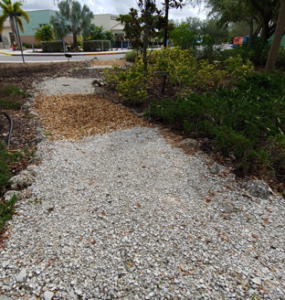
The surface trail above has different sections of sand, pebbles, and mulch. The different surfaces allows the puppies to experience walking on multiple surfaces that they could encounter in their futures as working dogs.
Below are examples of distractions and novel items that can be added to the area before the walk.
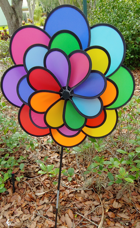
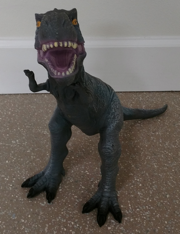
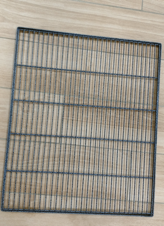
Wind spinner- Similar brightly colored wind spinners or windsocks can be strategically placed along the walking path. These items move in the wind and allow puppies to explore them along the way. Make sure to hang windsocks at the puppies’ height.
Dinosaur Toy- Place statues or objects in different places along or in the walking path. This allows puppies to encounter novel items to explore along the way. Make sure that the bar spacing is small enough that the puppy’s paws will not get stuck.
Metal Grate- Different surfaces can be placed in the walking path for puppies to walk over. Be creative and use different textures that they may encounter in their future such as tarps, metal pans, etc. Having items that they are already familiar with in different locations allows puppies to generalize from past experiences with the items.
Depending on the age of the puppies in your facility, these crate games can be useful for older puppies as it reinforces many of the skills learned plus teaches self control. Puppy should be comfortable and already have positive associations with the crate, which these games can build on. Start with the first stage and progress at a level the puppies can manage – repeat stages as needed to reinforce the skill and enable puppy to succeed.
Stage 1
- Open the crate door and stand facing the open doorway with pup on short lead
- Wait for pup to go into crate of own accord (do not give pup any instruction or eye contact) NOTE: DO NOT TOUCH YOUR TREAT POUCH UNTIL PUP HAS GONE INTO THE CRATE
- As soon as pup goes in, pay with treat high (e.g. hold treat higher to encourage puppy to remain in a sit position) and at the back of the crate to inadvertently cue a sit behaviour
- Remove pups lead, close the door, and take a step away
Stage 2
Stage 2 follows immediately from stage 1 so pup is in crate without a lead
- Crouch down, open crate then treat high and at the back of the crate
- Close door and step away
- Repeat several times
NOTE: If at any time the pup moves out of a sit or down position, close the door and step away again. Wait a moment then try again.
Stage 3
Stage 3 follows immediately from stage 2 so pup is in crate without a lead:
- Crouch down, open crate and clip lead 3 times beside pup’s collar without connecting it (pup is learning not to get excited when it sees the lead in our hand)
- Treat high and at the back of the crate
- Close door and step away
- Repeat several times
NOTE: If at any time the pup moves out of a sit or down position, close the door and step away again. Wait a moment then try again.
Stage 4
Stage 4 follows immediately from stage 3 so pup is in crate without a lead
- Crouch down, open crate
- Attach lead to pups’ collar
- Treat high and at the back of the crate
- Detach lead from pup’s collar
- Close door and step away
- Repeat several times
NOTE: If at any time the pup moves out of a sit or down position, close the door and step away again. Wait a moment then try again.
Stage 5: The Gamble
Stage 5 follows immediately from stage 4 so pup is in crate without a lead
- Crouch down, open crate
- Attach lead to pups’ collar
- Stand back with pup on lead and door open
- Wait 1-3 seconds
- Mark and treat high and at the back of the crate
- Remove the lead
- Close crate door and move away
- Repeat several times
NOTE: If at any time the pup moves out of a sit or down position, close the door and step away again. Wait a moment then try again
Stage 6
Stage 6 follows immediately from stage 5 so pup is in crate without a lead
- Crouch down, open crate
- Attach lead to pups’ collar
- Treat high and at the back of the crate
- Stand back with pup on lead and door open
- Wait 1-3 seconds
- Present target hand outside the crate to encourage dog to leave crate
- When pup targets, mark but DO NOT TREAT (Value needs to be in entering and being in crate, not when exiting it)
- Immediately turn around and lure pup to stand back in front of open crate door
- Keep lead short and wait until pup goes into crate again (same as in stage 1)
- Mark and treat high and at the back of the crate
- Repeat several times gradually increasing length of wait before targeting pup out of crate
NOTE: If pup tries to exit before the target hand is presented, immediately close the door to crate, step away and try again in a few minutes.
